Milan, a city synonymous with footballing passion, finds itself at a curious crossroads. San Siro, the legendary Giuseppe Meazza stadium, still draws sell-out crowds for both AC Milan and Inter, yet a palpable silence has descended upon its usually raucous curves. The absence of the traditional `ultras` – the fervent, organized fan groups – has created a peculiar paradox: a full stadium that`s strangely muted. This isn`t merely a shift in atmosphere; it signals a fundamental re-evaluation of Italian football`s fan culture, prompting a search for a `third way` between unbridled, sometimes violent, passion and an eerily quiet `salon stadium`.

- The Milanese Paradox: A Full House, a Silent Stand
- The “Third Way”: Finding Balance Between Passion and Punctiliousness
- Lessons from Across Europe: Diverse Approaches to Fan Culture
- Spain: The Rise of the “Animation Stands”
- England: From Hooliganism to Hospitality
- France: PSG`s Curated Comeback
- Germany: Differentiating Ultras from Hooligans
- The Future of Italian Football`s Voice
The Milanese Paradox: A Full House, a Silent Stand
The situation in Milan is a direct consequence of concerted efforts by authorities. Following legal action against prominent ultra leaders and a subsequent decision by the Public Prosecutor`s Office, law enforcement, and the Prefecture, hundreds of Inter and Milan ultras have been denied season ticket renewals. This crackdown, aimed at curbing criminal elements and violence often associated with these groups, has effectively “decapitated” the organized support structures in the curva (curves) of the stadium.
The impact has been immediate and undeniable. Without the relentless drumming, synchronized chants, and large-scale choreographies orchestrated by the ultras, the general crowd, though still numerous, remains largely passive. As one Milanista fan wryly quipped, “It`s not bad starting the season with a 2-0 win at Bari…” — a testament to the strange, almost sterile atmosphere now dominating matches. The emotional “12th man” that could lift a team in moments of struggle is noticeably absent, leaving a void that casual applause and spontaneous cheers simply cannot fill. For a league that thrives on its raw, visceral fan base, this transformation is nothing short of revolutionary, and for some purists, perhaps a little unnerving.
The “Third Way”: Finding Balance Between Passion and Punctiliousness
Milan`s “salon stadium” era might inadvertently serve as a testbed for Italian football. The challenge is immense: how to cultivate an energetic, supportive atmosphere without tolerating the violent or illicit activities that often fester within organized ultra groups. The solution, many believe, lies in finding a “third way” – an alternative to both hooliganism and a soulless, quiet arena. While the curves at Meazza remain semi-full, a sense of solidarity and silent protest among remaining fans, coupled with the sheer difficulty of spontaneously replacing deeply ingrained habits, means the stadium`s collective voice is dramatically diminished.
The question looms large: can the passion of the healthy majority of fans be re-ignited and organized in a new, acceptable form? Or will Italian football, with its deeply rooted traditions, struggle to adapt to a more sanitized, Anglo-Saxon model? This isn`t just about noise levels; it`s about the very identity of the matchday experience, something that has historically drawn even global celebrities like Spike Lee and Kanye West to witness the spectacle of the Italian curva.
Lessons from Across Europe: Diverse Approaches to Fan Culture
As Italy grapples with its fan identity crisis, other major European leagues offer varied blueprints, each with its own successes and compromises.
Spain: The Rise of the “Animation Stands”
In Spain, giants like Real Madrid and Barcelona have long since purged their stadiums of violent ultras. They`ve opted for a more controlled environment, sometimes even employing “Grada de animacion” – organized groups of 300-400 individuals tasked with leading chants. While this ensures a level of atmosphere, it can often feel manufactured. Stadiums are full, boosted by rising ticket prices and a growing international audience, but the ambiance, particularly at clubs like Barcelona playing in a temporary “cold” Montjuïc, is often described as a “salon” experience. Other clubs like Atletico Madrid and Sevilla retain organized groups, though without the violence seen in the past.

England: From Hooliganism to Hospitality
The Premier League underwent its own profound transformation decades ago, effectively eradicating hooliganism through stringent stadium cameras, severe penalties, and a culture of accountability. Today, English stadiums are consistently full, devoid of smoke bombs or extensive banners, yet maintain a fervent atmosphere driven by genuine individual passion. There are no groups dictating the rhythm of chants. Modern, multi-functional stadiums like Tottenham Hotspur Stadium perfectly exemplify this new approach: integrating traditional fan spirit with state-of-the-art VIP experiences, retail, and entertainment. It`s a blend that caters to both the “old style” fan and those seeking a broader, more luxurious event experience – a stadium that thrives seven days a week, not just on match days. One could almost attend a Beyoncé concert and then a football match in the same week, a testament to its seamless versatility.

France: PSG`s Curated Comeback
France presents a more complex narrative, particularly with Paris Saint-Germain. Following a tragic period of violence culminating in deaths in 2010, ultra groups were disbanded. This paved the way for the club`s sale and a subsequent, carefully managed reintroduction of organized support. The Collectif Ultras Paris (CUP) in the Auteuil stand, and more recently a “branch” in the Boulogne stand, now orchestrate chants and displays, but under strict club and police monitoring. PSG`s Parc des Princes is one of Europe`s most profitable stadiums, thanks to aggressive commercial policies, VIP boxes, and family-friendly sections, consistently selling out its 48,000 seats. For the rest of France, ultras are closely monitored, and prefects frequently ban away fans based on rivalries and past incidents, indicating a strong regulatory hand.

Germany: Differentiating Ultras from Hooligans
Germany stands out for its nuanced approach, drawing a clear distinction between “ultras” and “hooligans.” Ultras, often recognized and respected, sometimes even sit on club boards, acting as a direct channel for fan concerns. They are fiercely traditionalist – for instance, protesting Monday night fixtures – but do so peacefully, seeking dialogue rather than confrontation. Hooligans, by contrast, are completely disassociated from clubs and stadiums, with fans themselves often assisting authorities in identifying wrongdoers via CCTV. German stadiums, renowned for their atmosphere, maintain this vibrancy while upholding the law, demonstrating that passionate, organized support can coexist with order and safety. German ultras are also frequently at the forefront of anti-discrimination efforts, showcasing a more positive community role.

The Future of Italian Football`s Voice
The challenge for Inter and AC Milan, and indeed for Italian football as a whole, is to navigate this complex landscape. While preserving the “salt of the match” – the giant choreographies, the scarves, the flares, and the thunderous chants that have defined Italian football – is crucial, the era of unchecked ultra influence appears to be drawing to a close. Can American-owned clubs like Inter and Milan, accustomed to a different sports entertainment model, successfully adapt and professionalize their fan engagement, perhaps even hiring specialists as Real Madrid and Barcelona have? Or will they find a uniquely Italian solution that blends tradition with modern security and accessibility?
The transformation of San Siro`s curves is more than just a local story; it`s a microcosm of a broader evolution in European football. The quest for a “third way” is about proving that the heart of the game can beat strong, passionately, and loudly, without the shadow of violence or criminality. It’s a journey that will redefine not just the matchday experience, but the very soul of Italian football.








